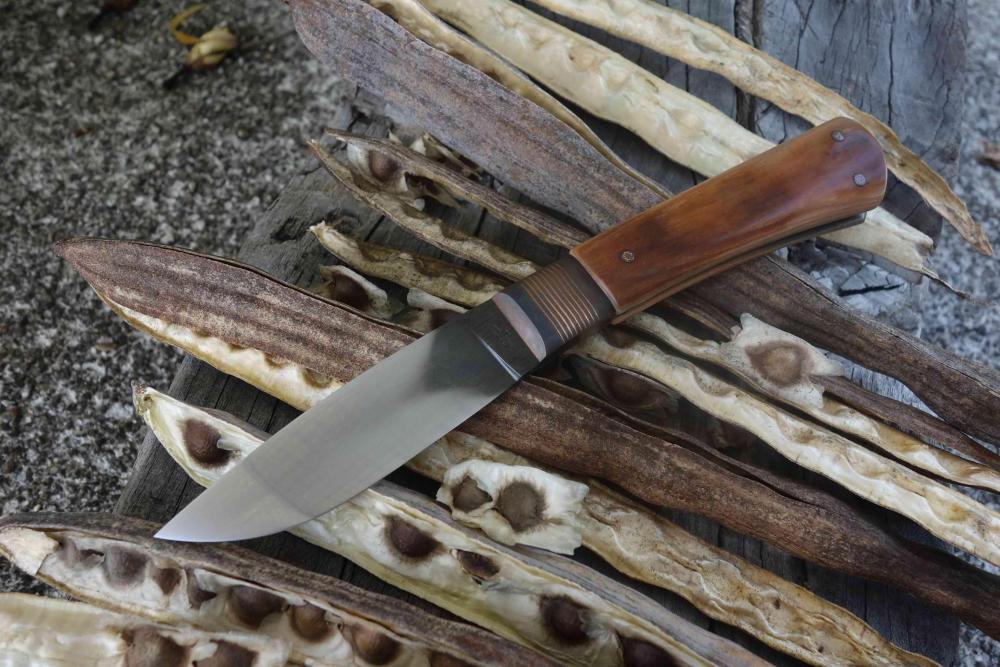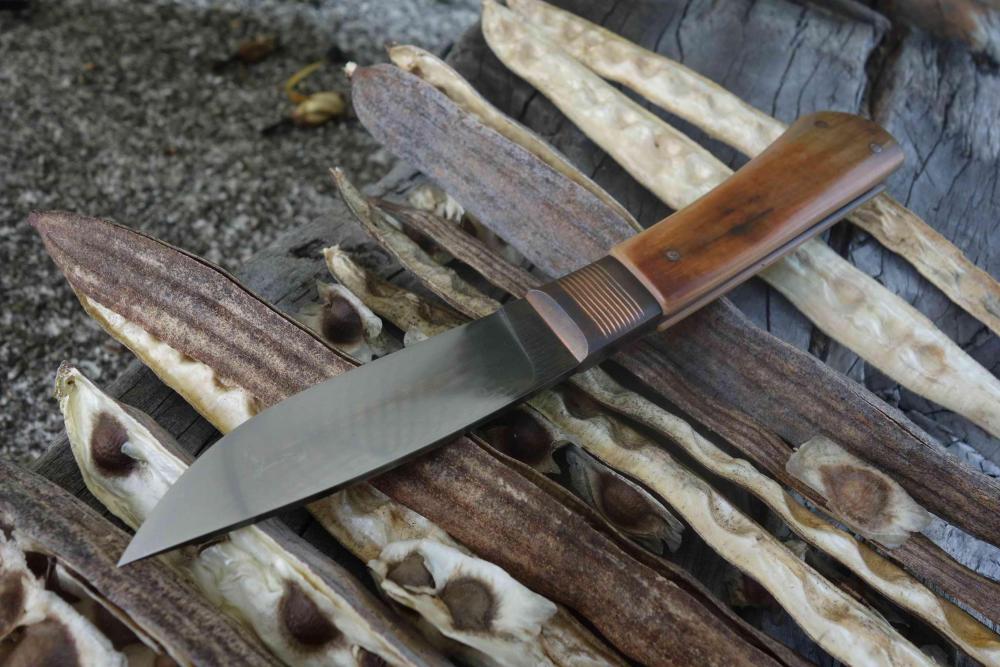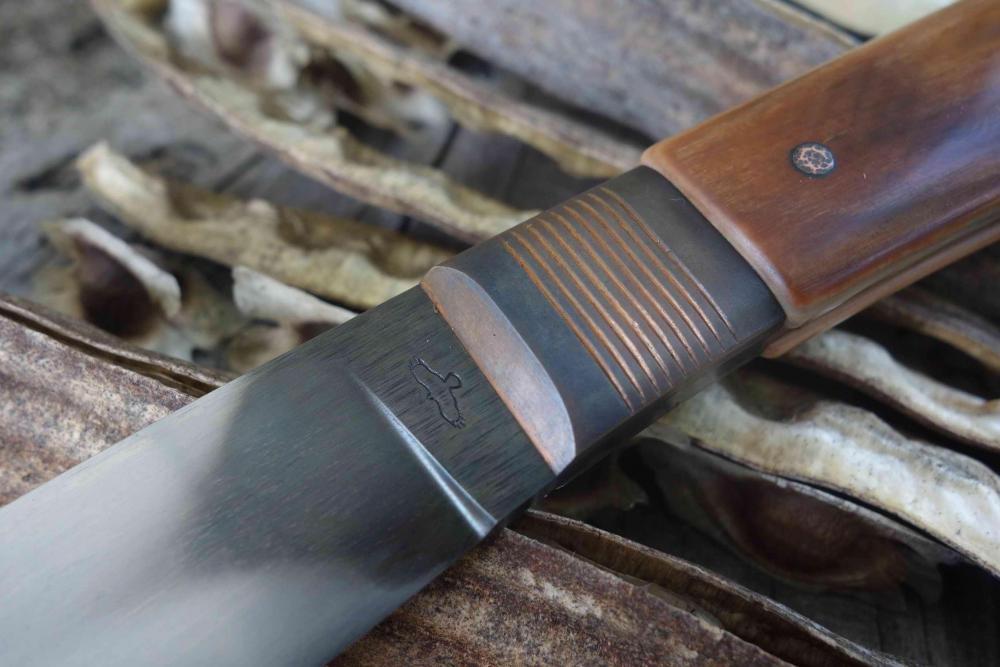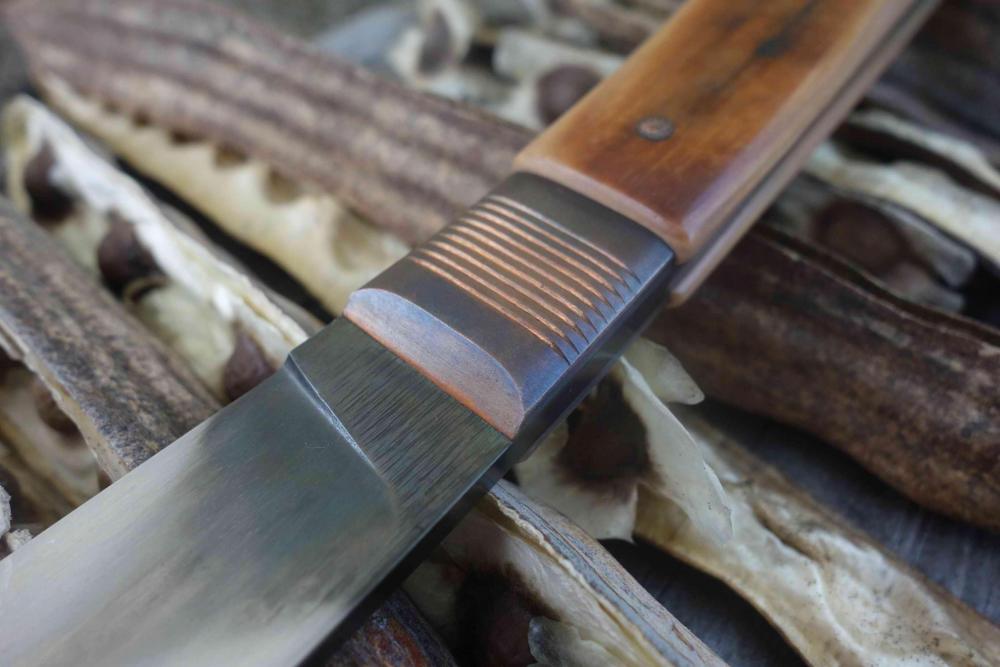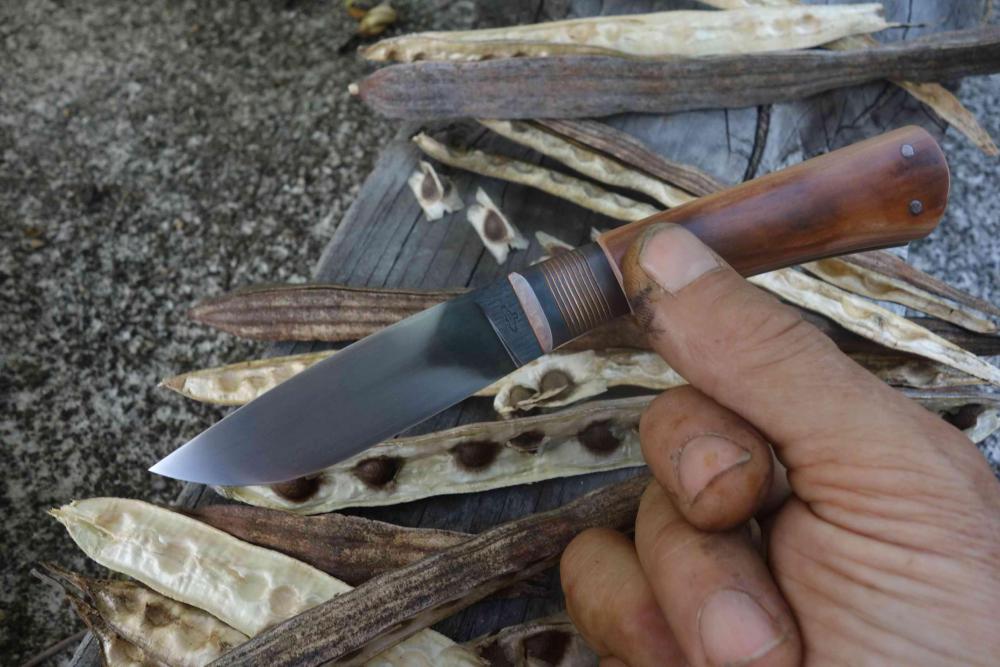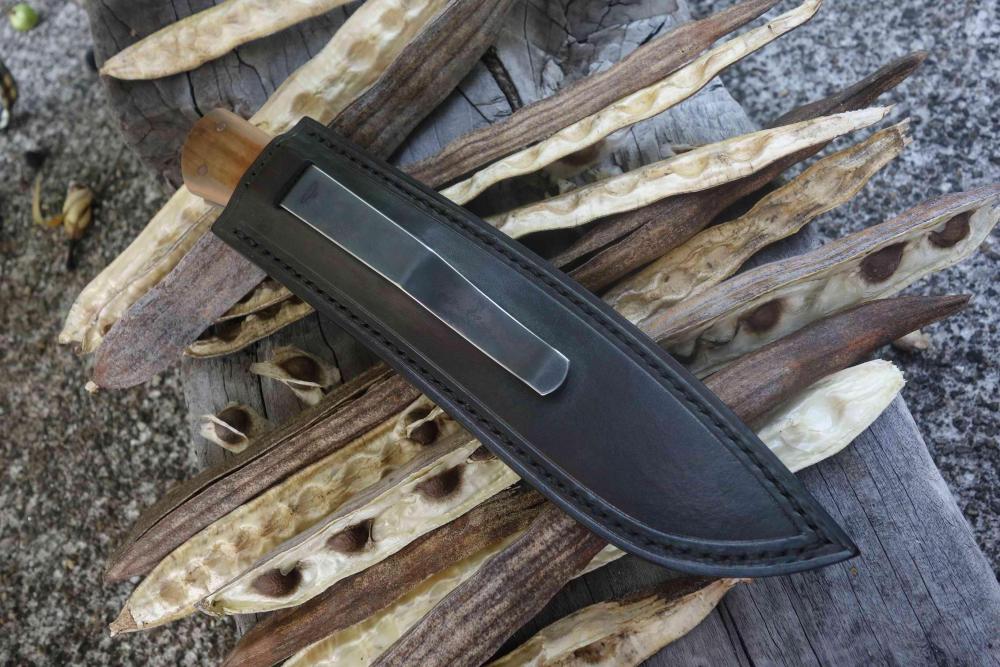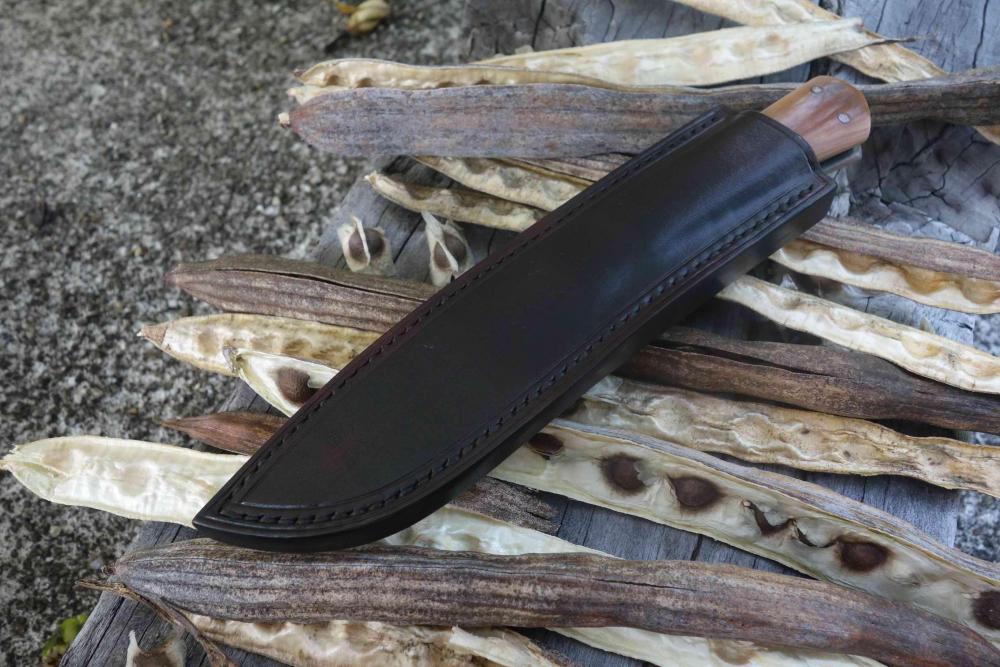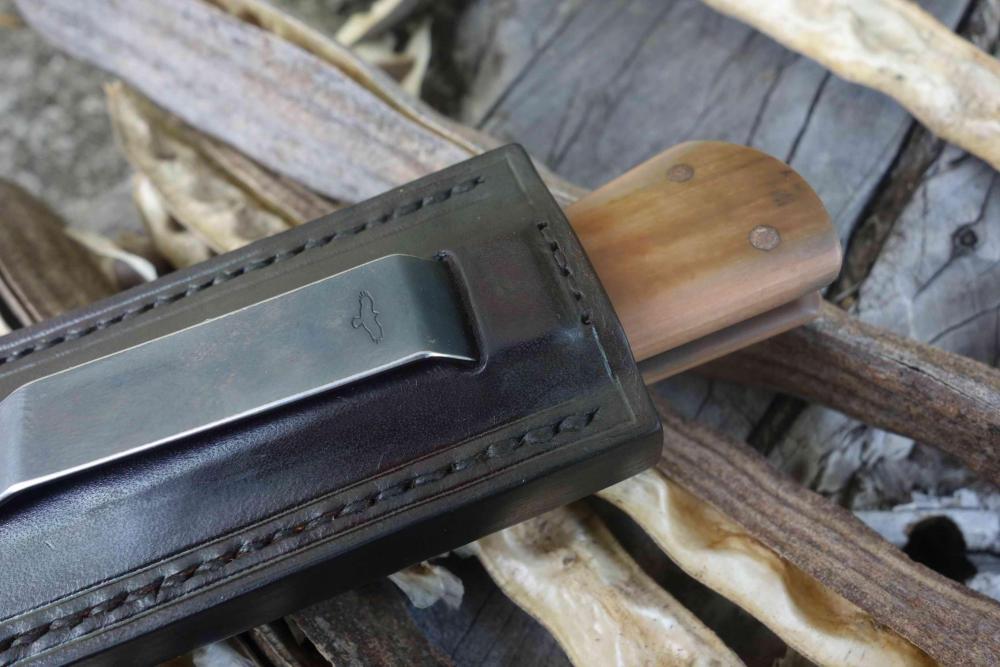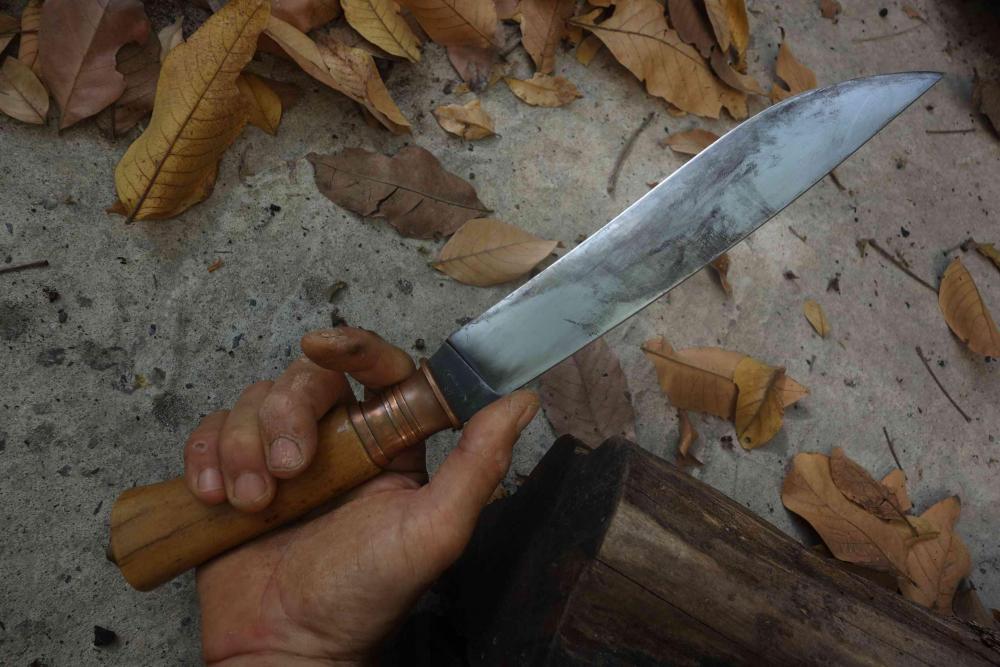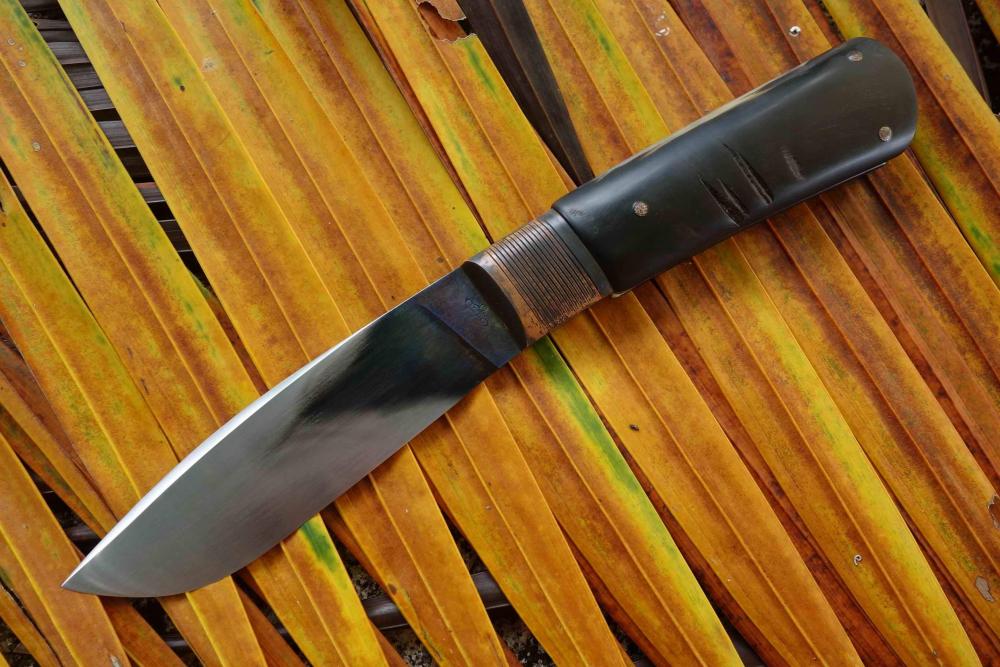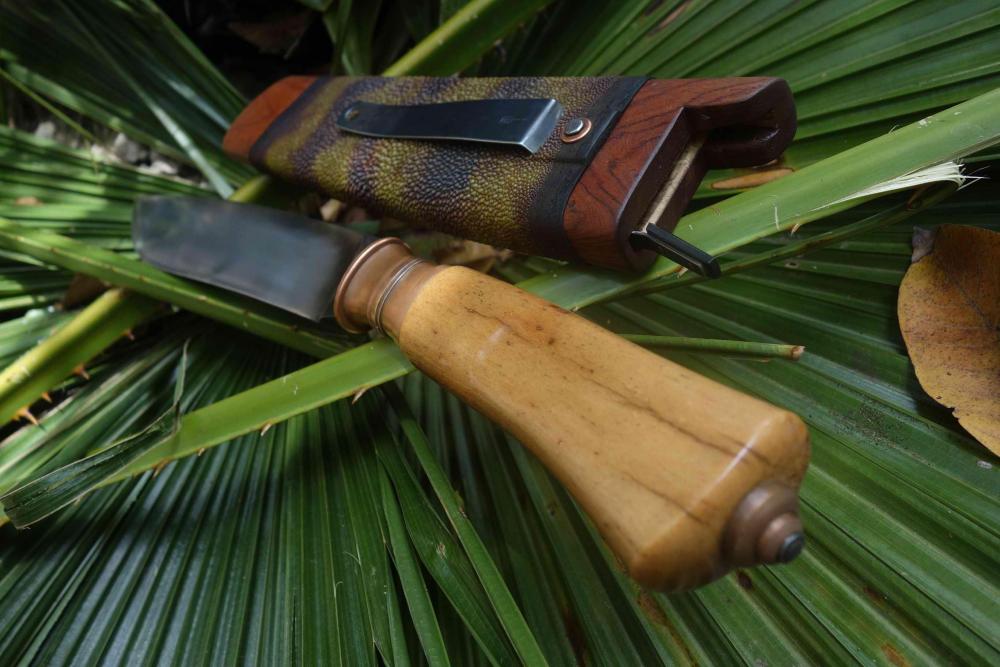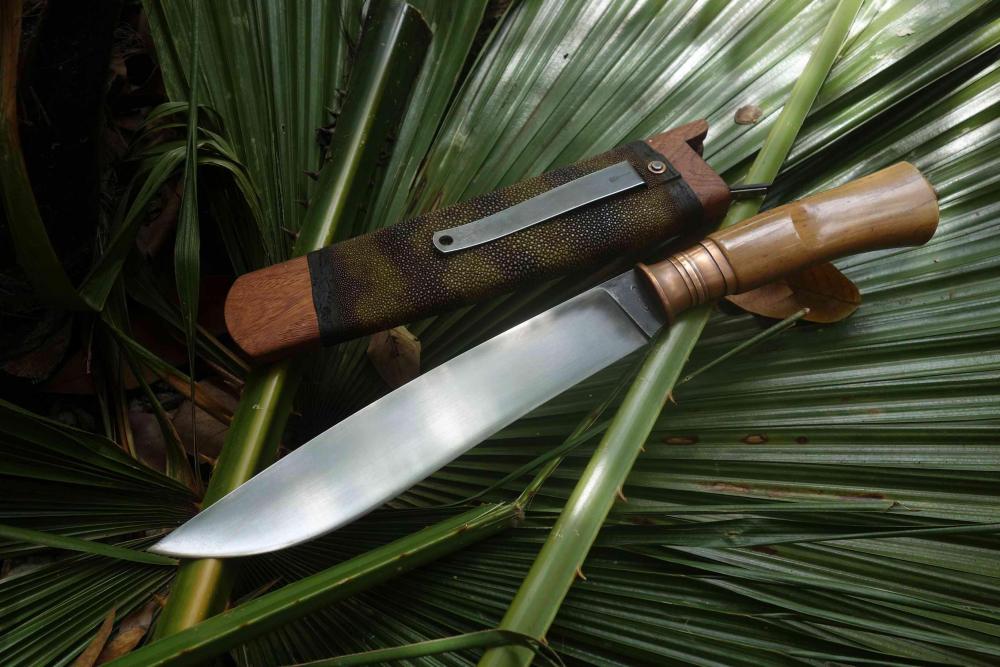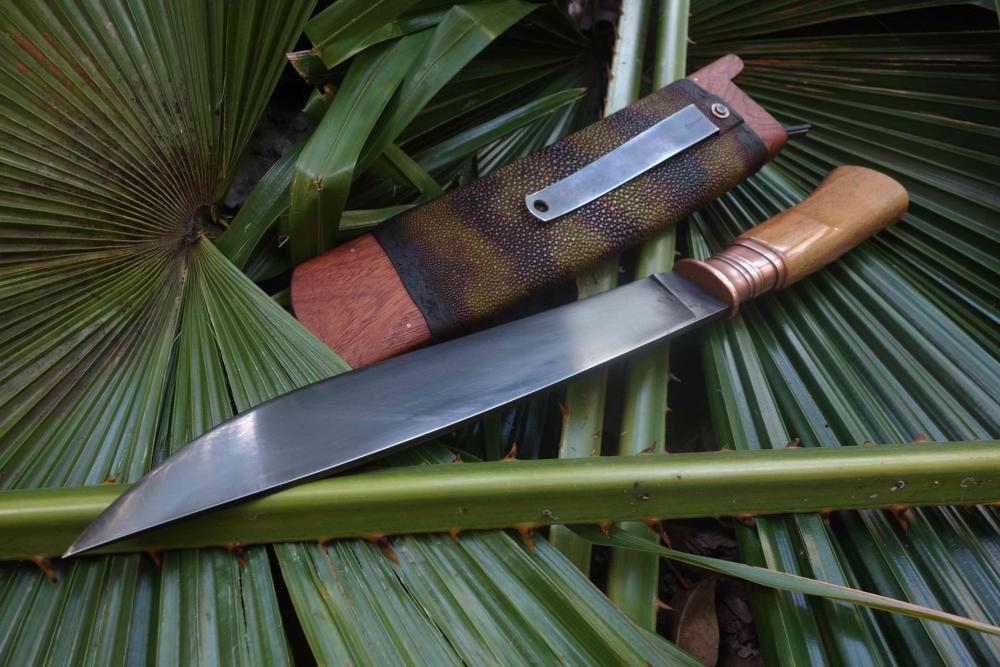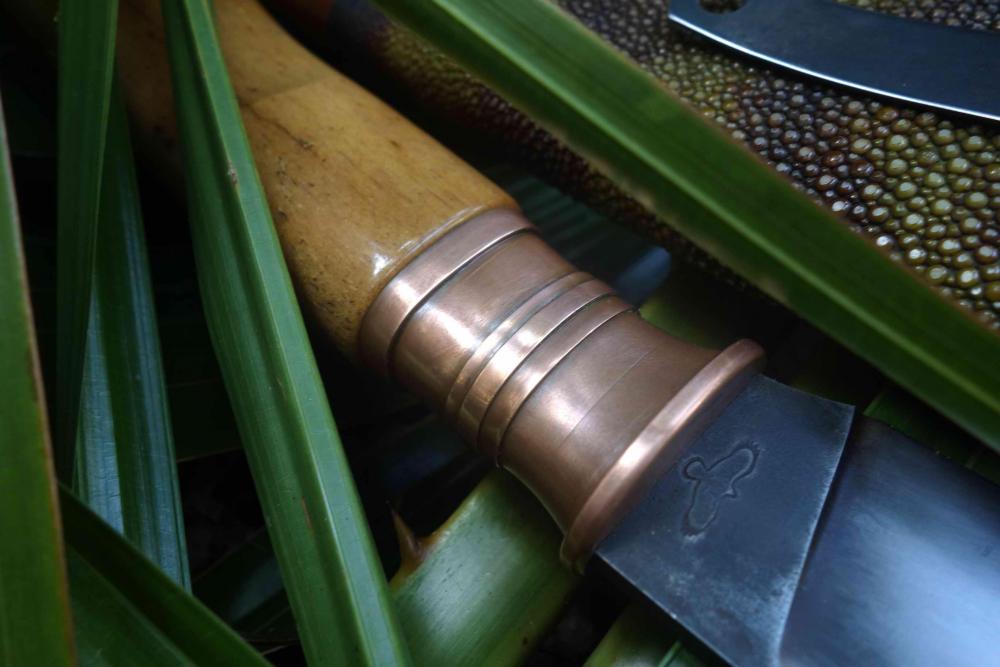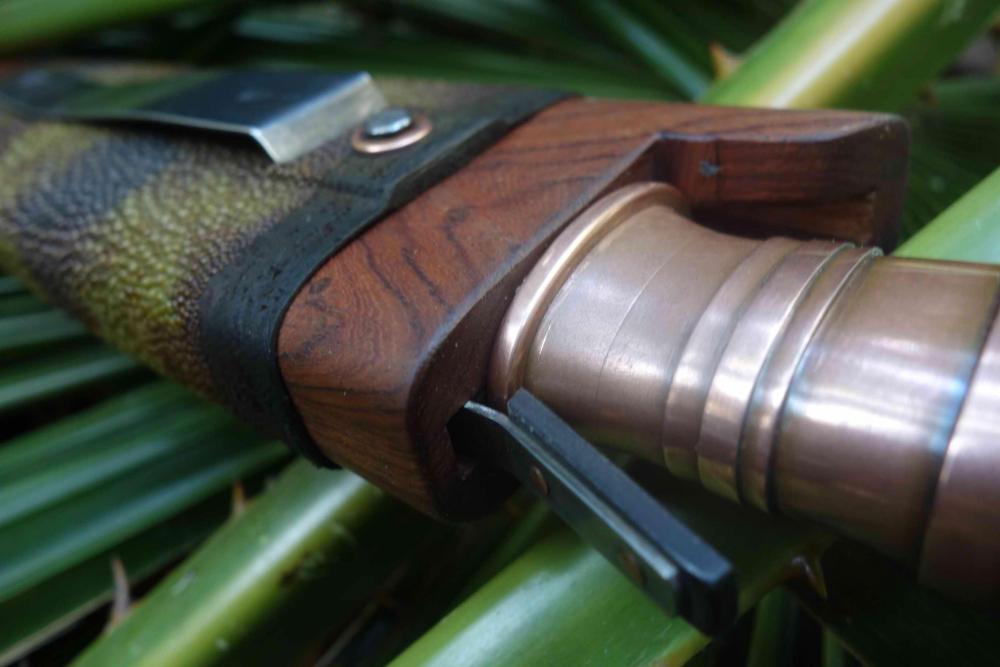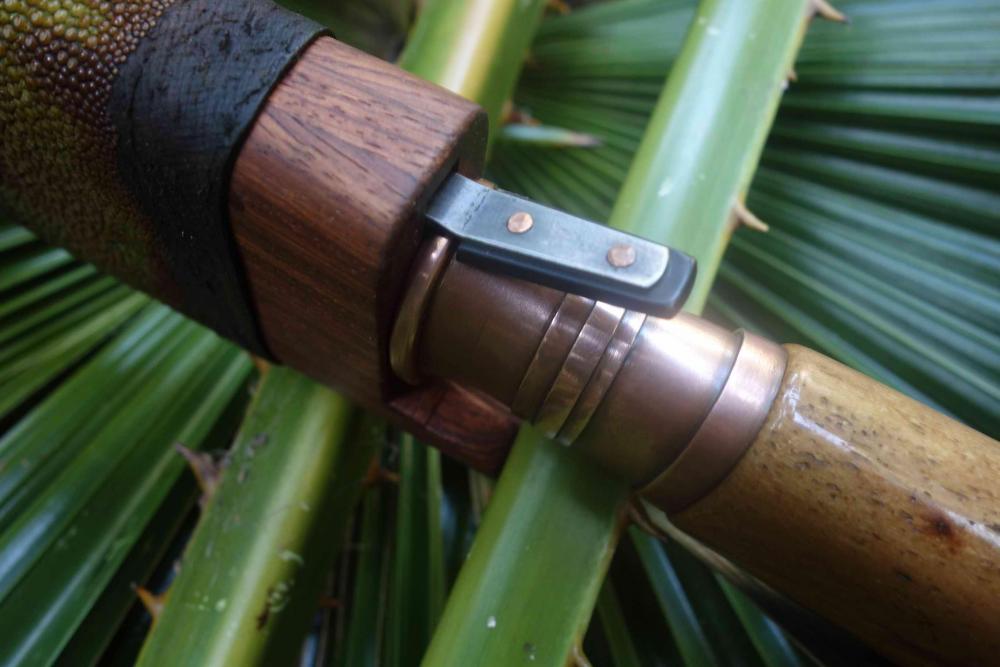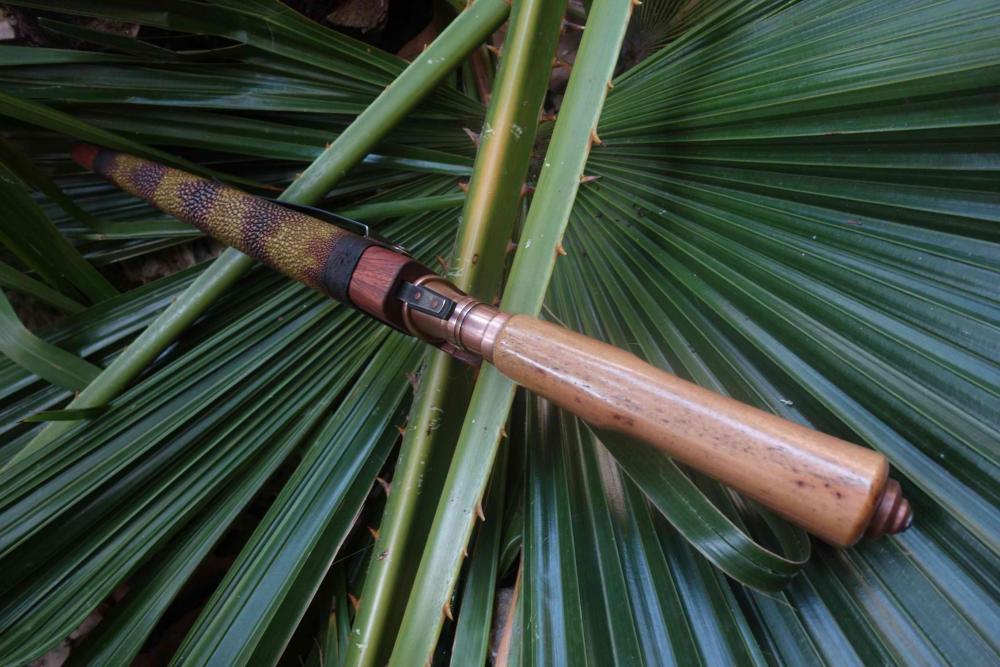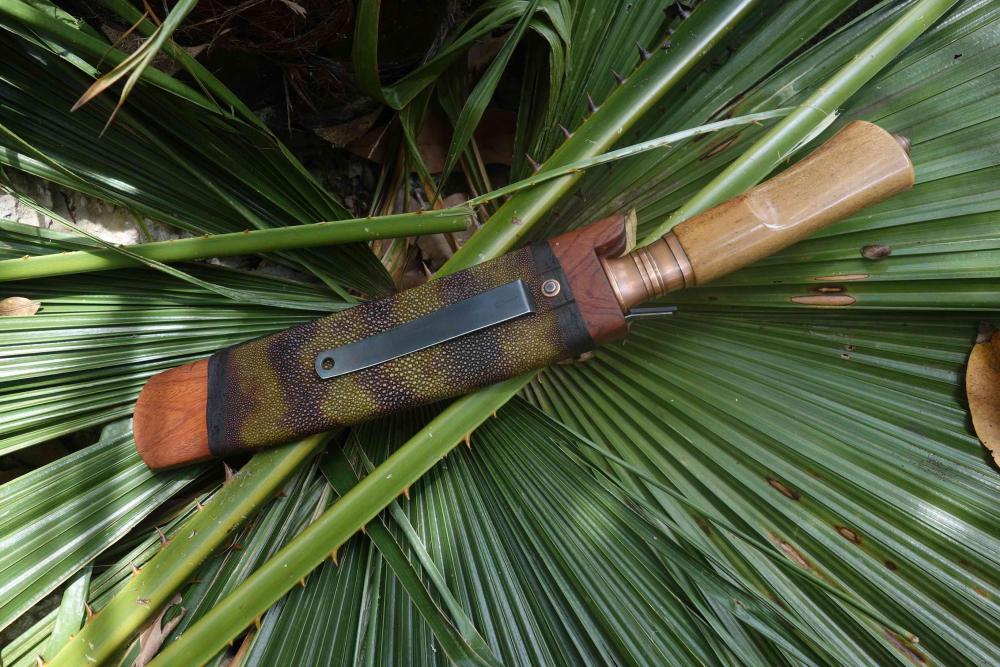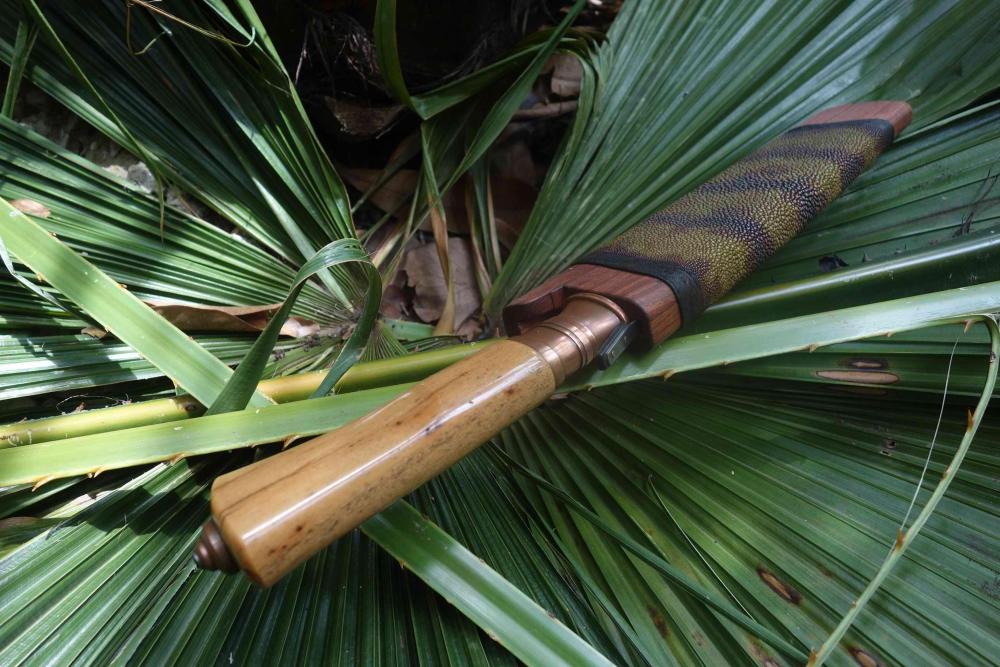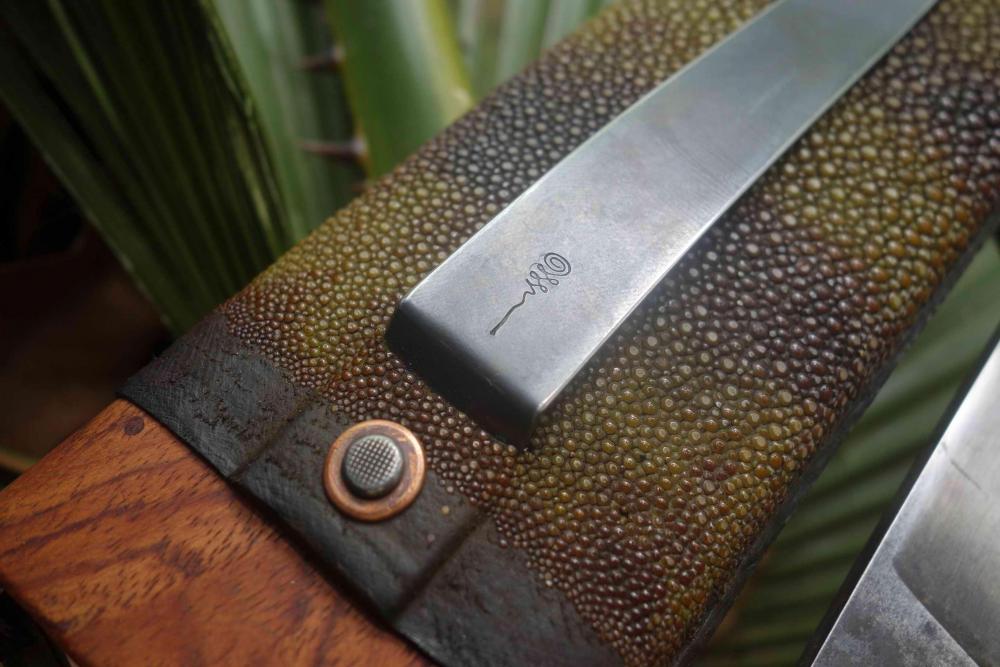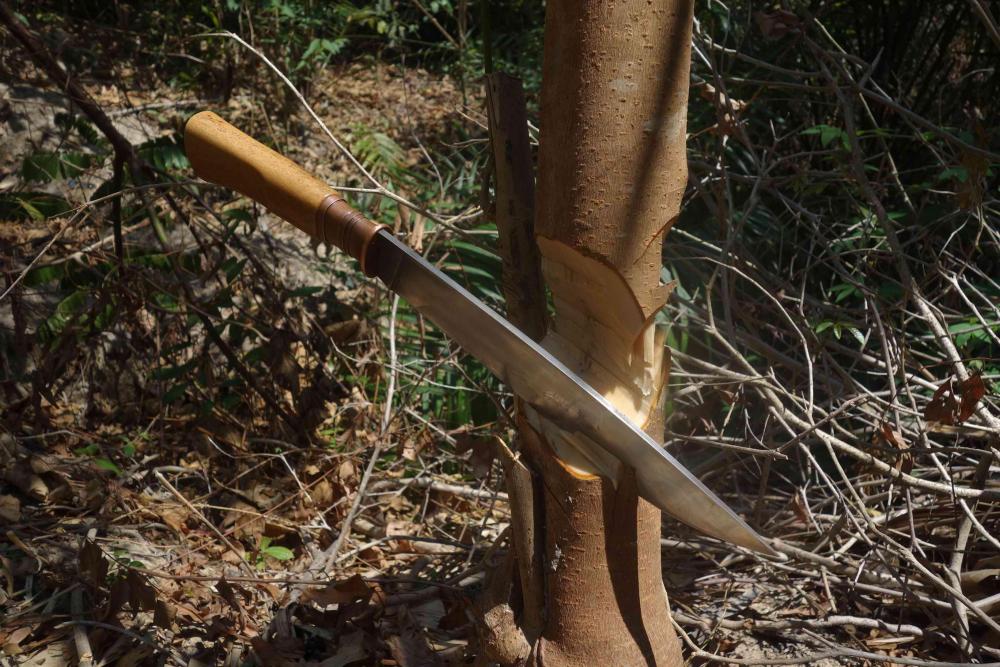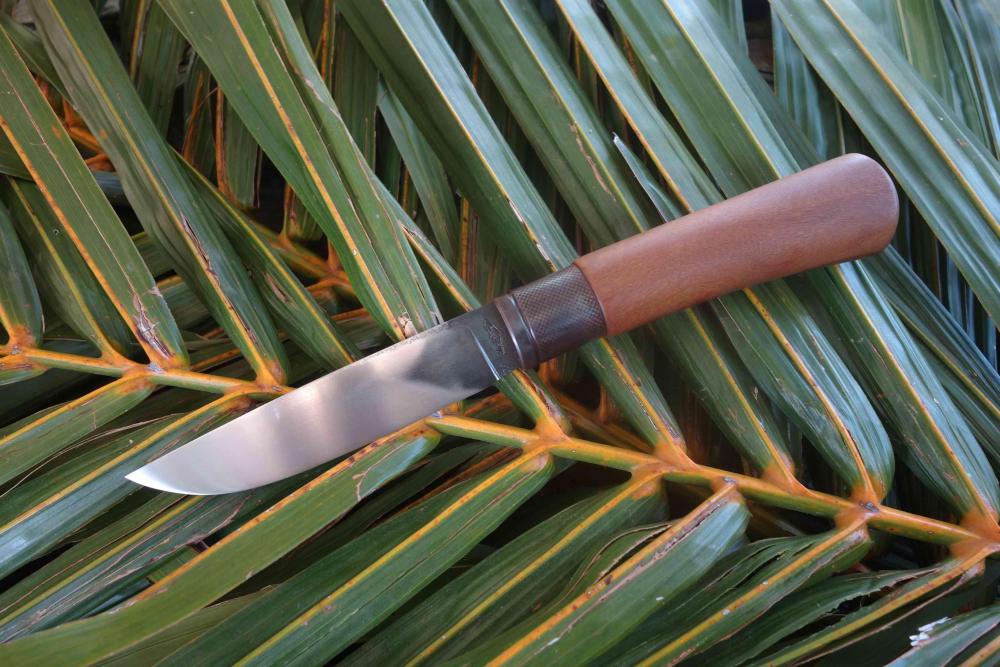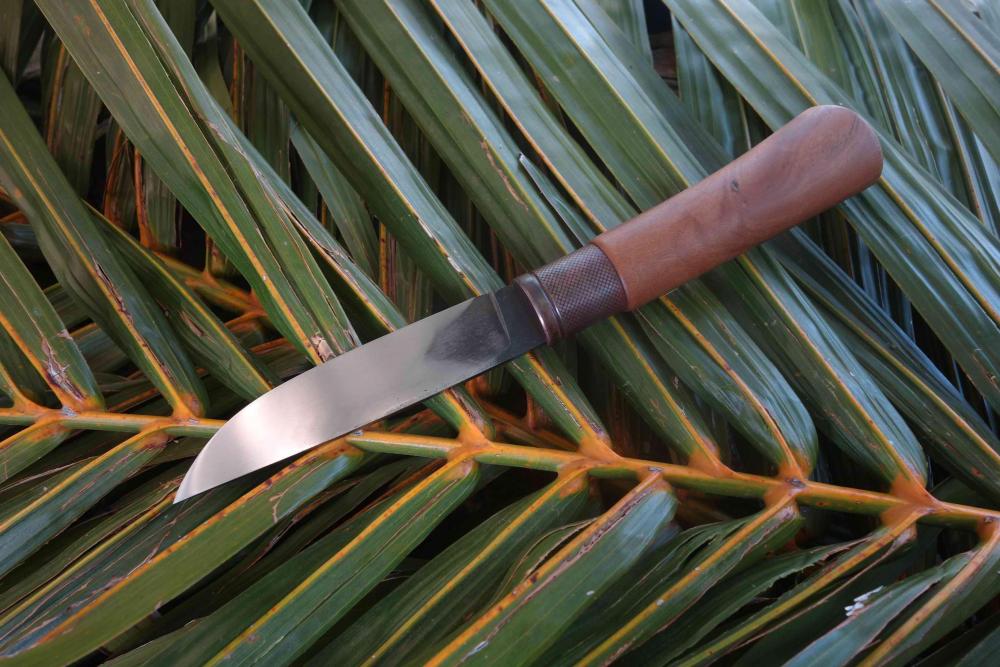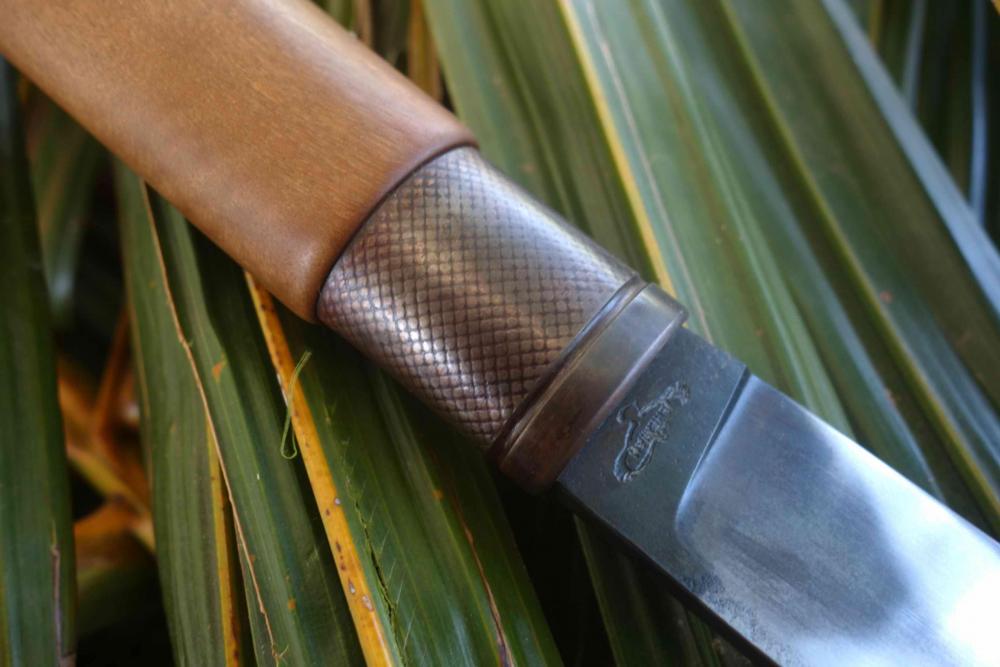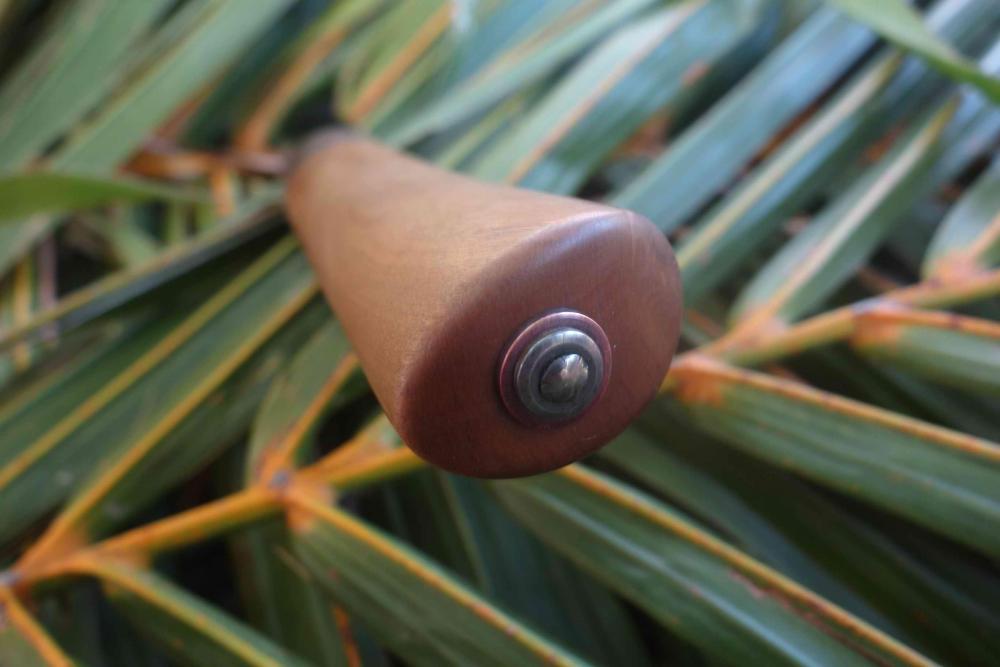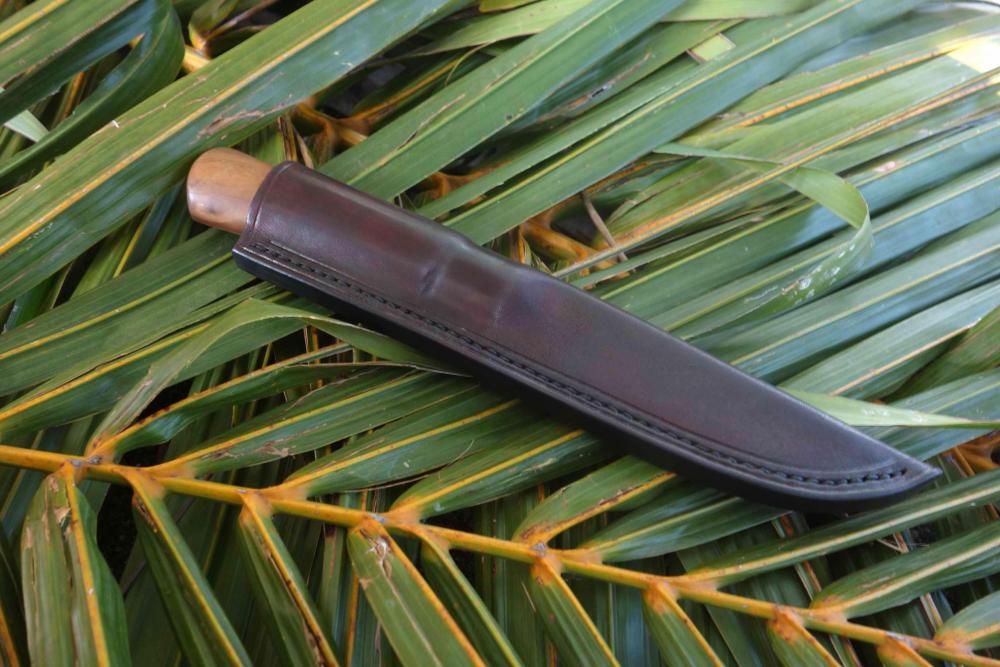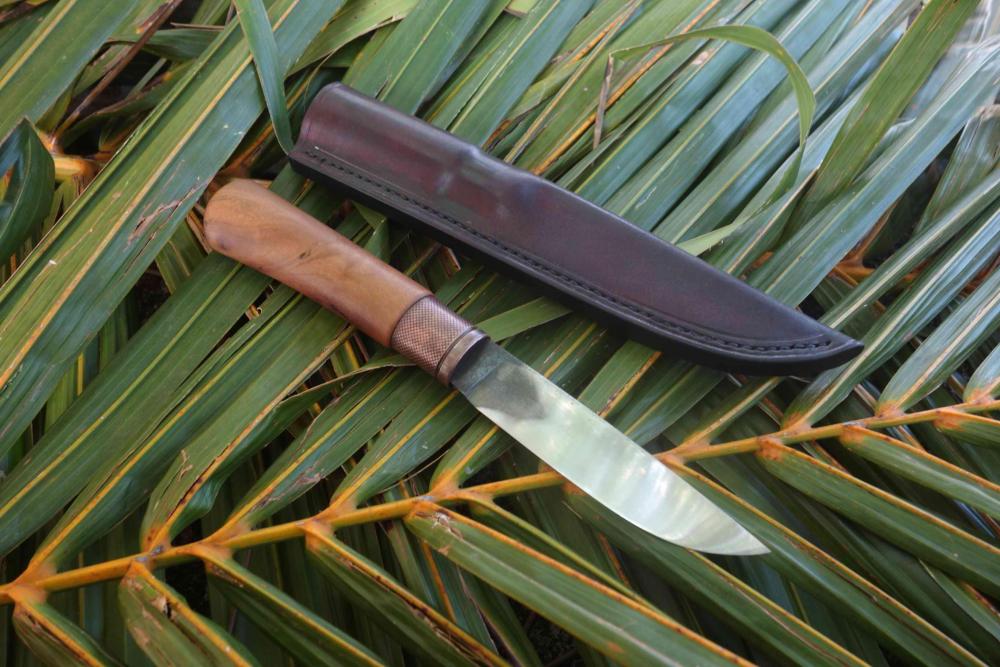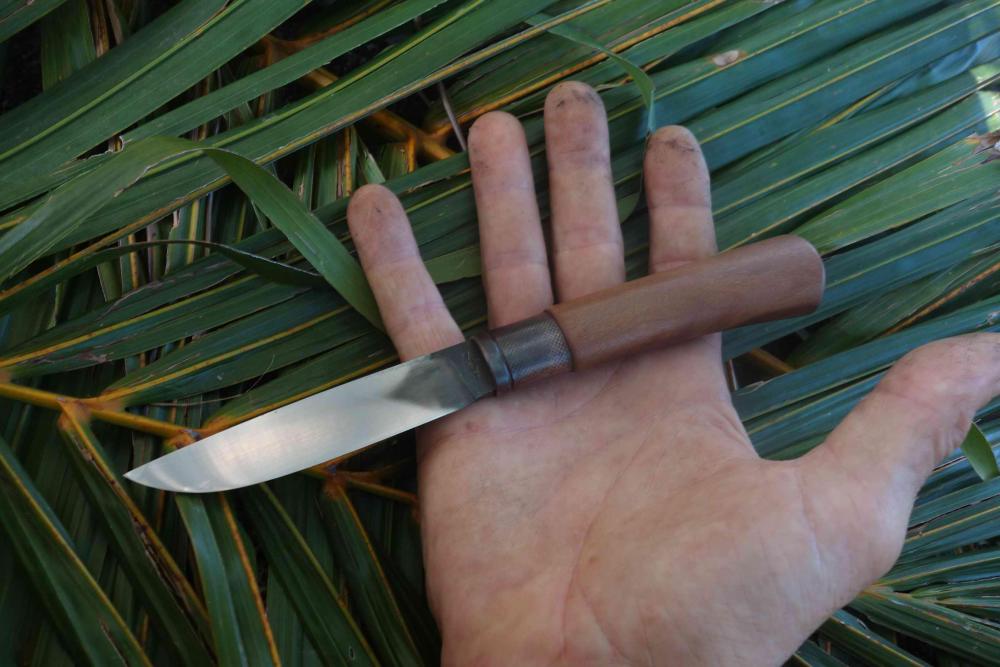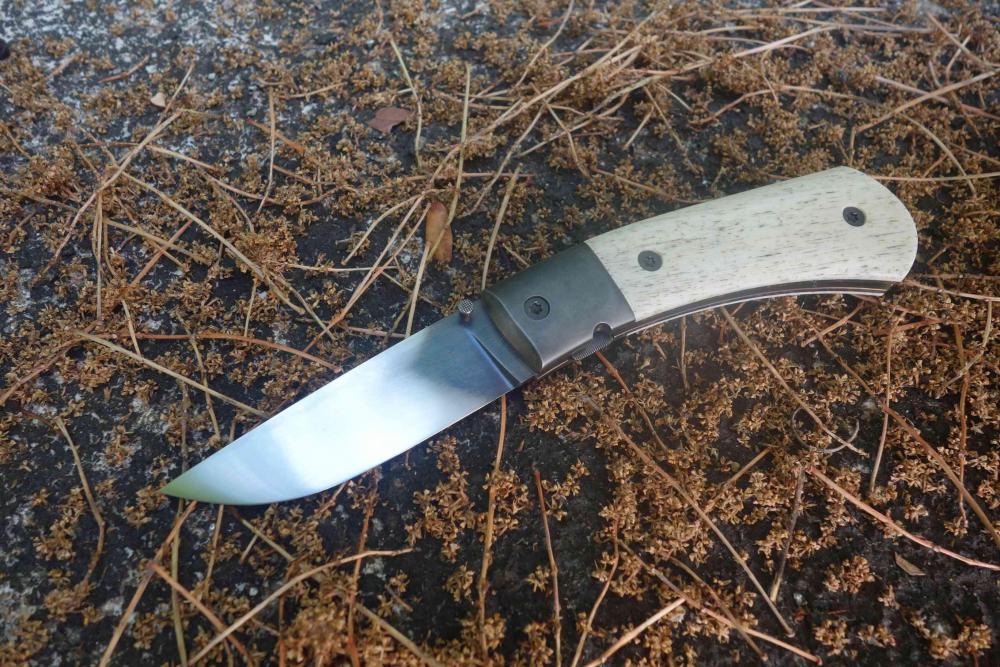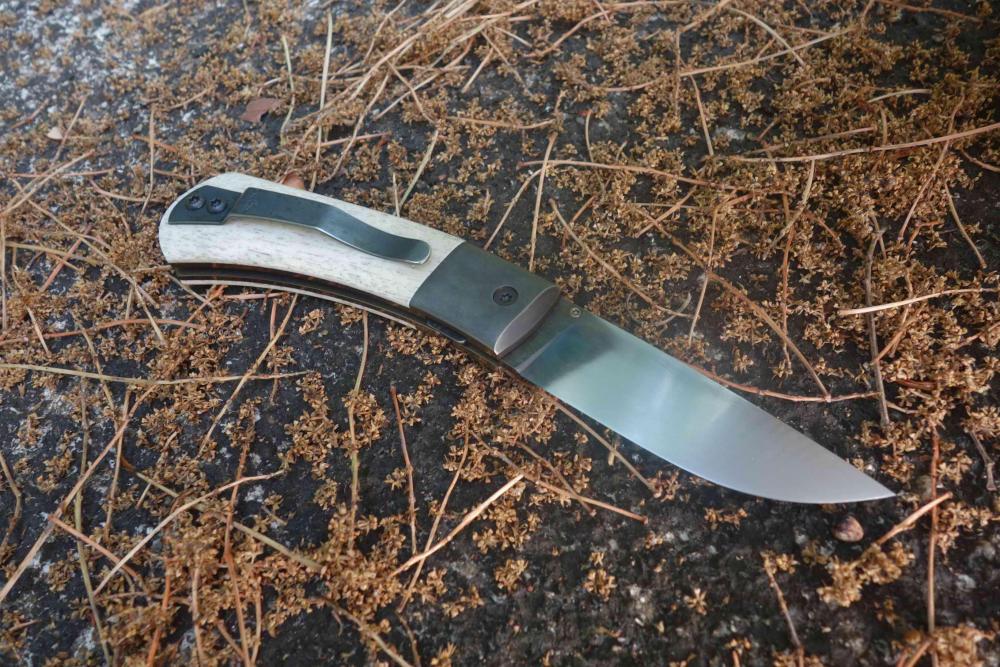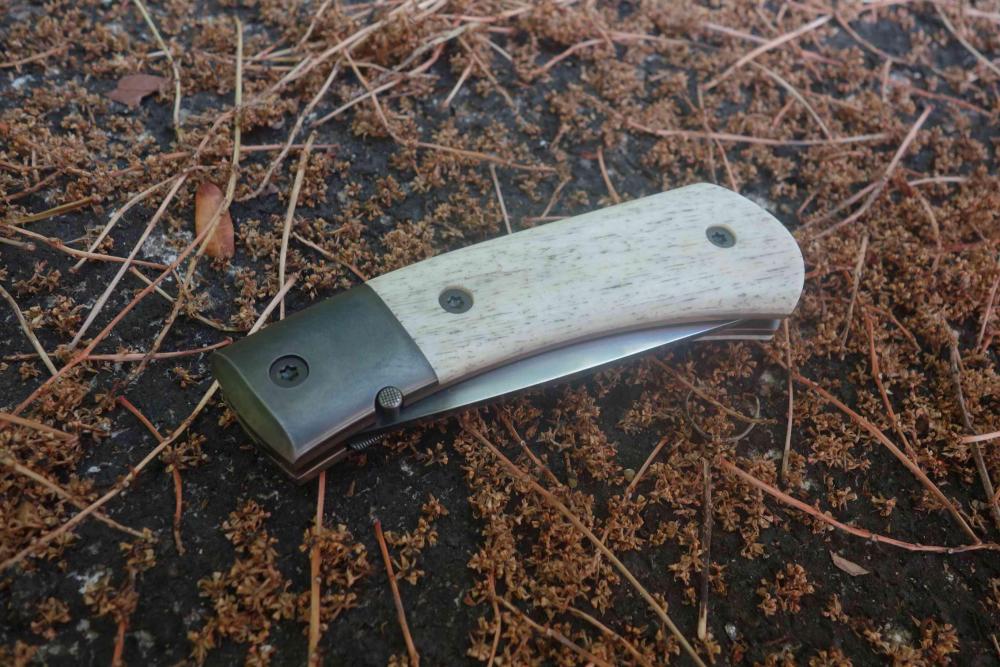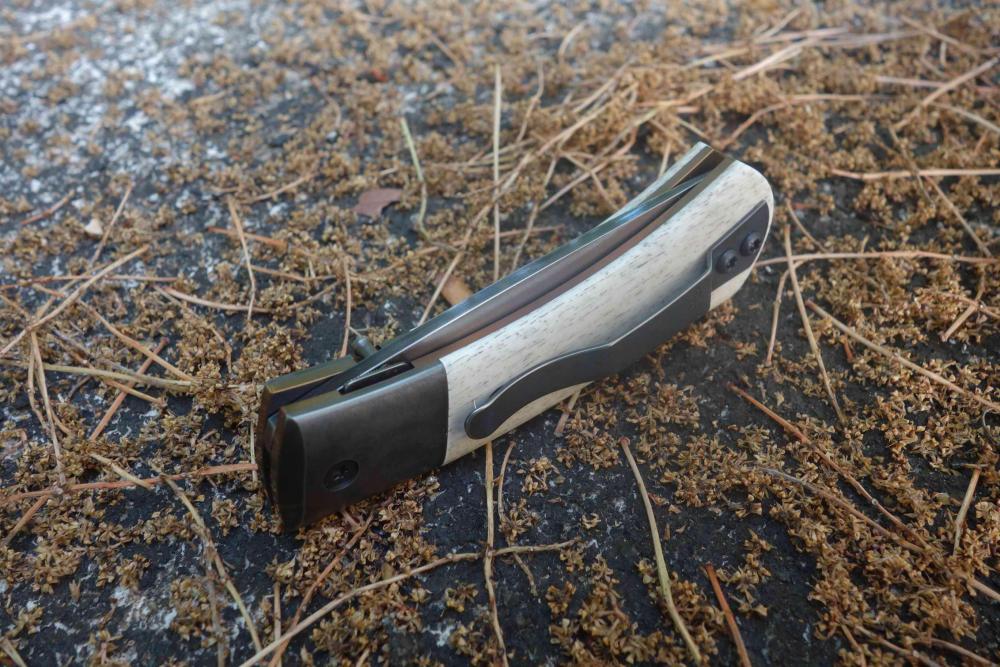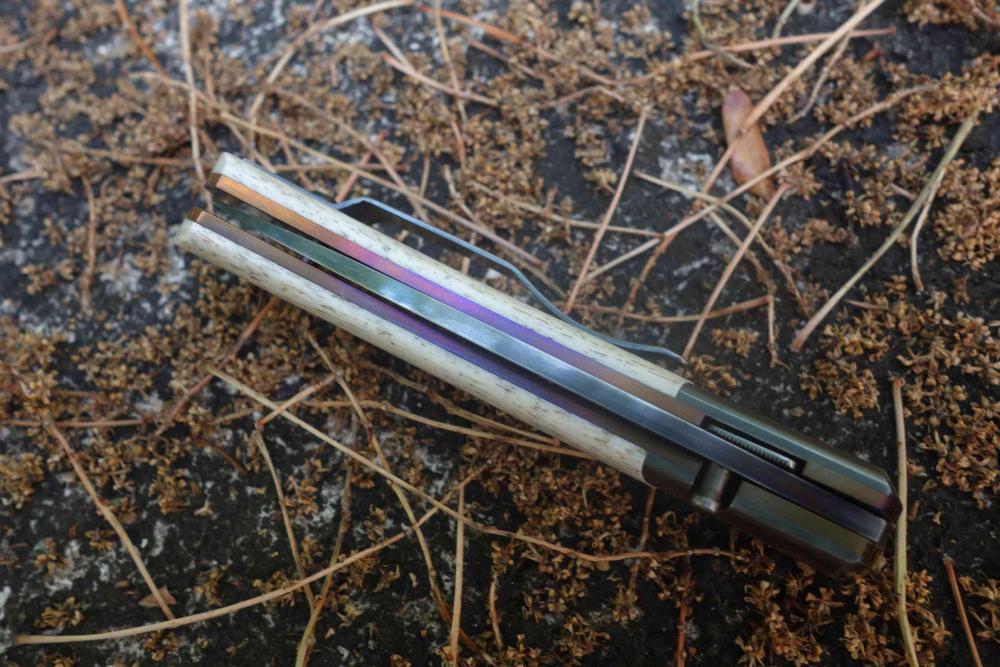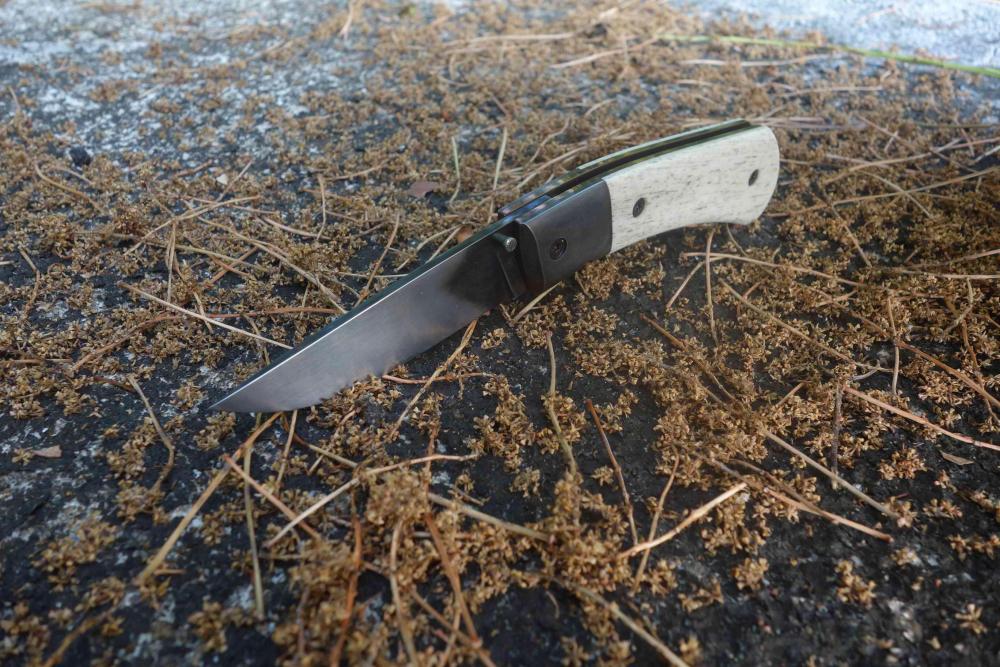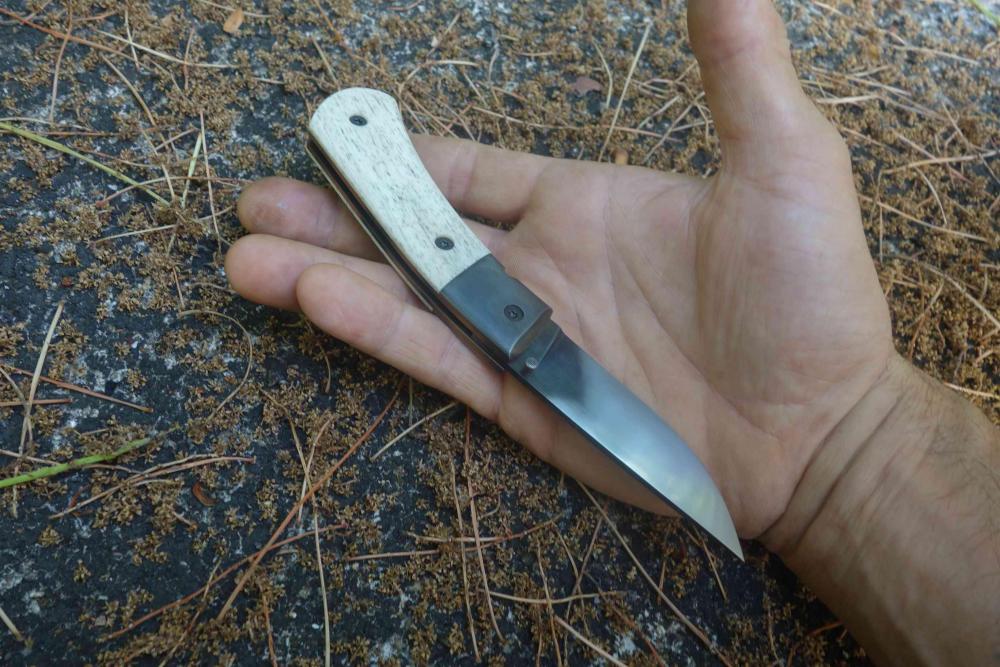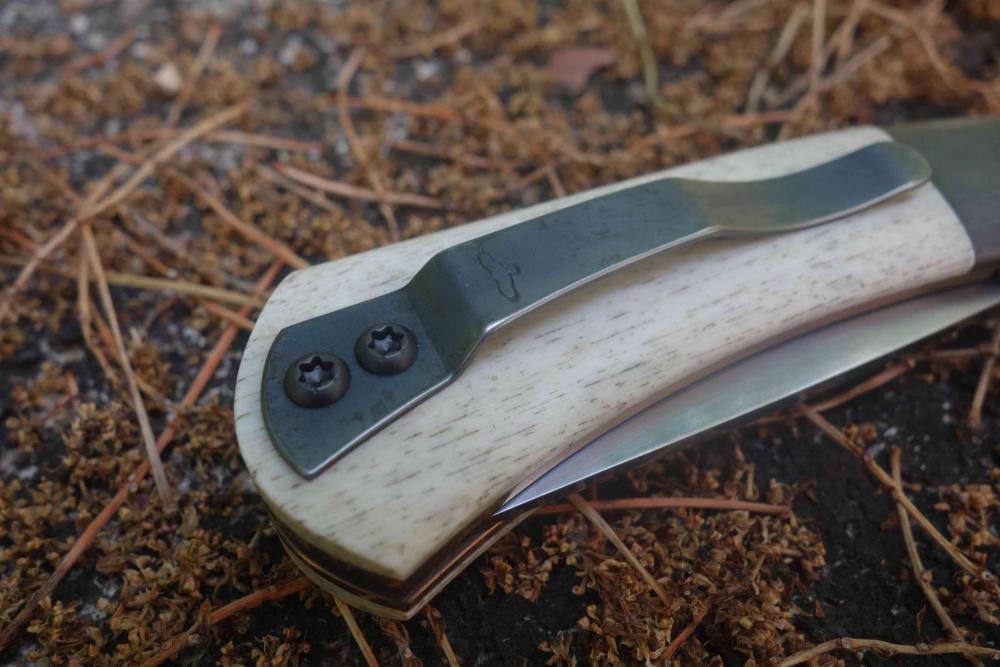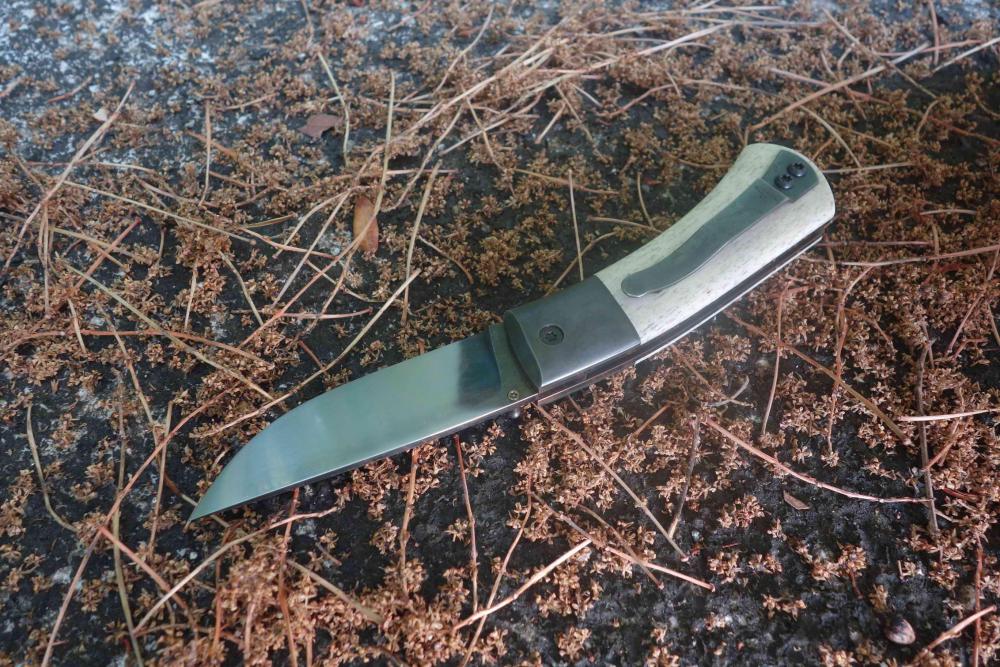-
Posts
448 -
Joined
-
Last visited
Content Type
Profiles
Forums
Articles
Gallery
Downloads
Events
Everything posted by templehound
-
A little gatherer, small and slender.... just like a splinter. The 87 mm long blade is forged and ground from TNTtriple6 and overall length measures 194 mm. .....and after the copper nothing else than orange and brown sugar Cheers
-
The bush sword with the hemp handle is my favourite....the straight point combined with the recurve looks nasty ...and the open back kydex sheath is super...less wide and well proportioned.
-
Well, sounds good....do it!
-
-
....I fear that is over my personal party budget....but if You are around, stop by and lets do a blade together.... ....with rams horn scales, of course Rams horn is tricky and sometimes can be frustrating to work with but it is so beautiful that I challenge the difficulties again and again. .....this man is into ramshorn, he says: "...is unique in his own way, because every single set up of horns comes with its unique set of problems."...that is the very truth. ....I like the video and I like the guy and his passion and I would like to share it with you guys....let there be horn. https://www.youtube.com/watch?v=zHDPg9RXUm0 Cheers
-
.... Frosty, I nearly felt tempted to tempt you You are looking at the right thing. I always finish the surface of the scale before riveting the doomed pins, and after that nothing can be done much more that wont create a circle around the pin head, which I do not want to happen. And You are right, constructing, working or grinding two completely different materials together equal, can offer a box full of weird and remarkable physics. ...actually it is a nice subject for its own topic....steel grinds in cross section much easier and cooler than length wise. On wood, especially hard- and ironwoods it is the same ....the same grain pertinent thing ....so equal and yet so different.....must be that Yin and Yang case...so different like when looking at "heat"..., you put a fresh plum in the sun, first it expands and then it pulls itself together and shrinks....but I am drifting away from topic...well, getting holes in rams horn is the red line of context. If we are funny, we could discuss the worst case scenario, when riveting goes bad and how to get the pin out, without damaging the horn.... ...and here textured rams horn is the winner....the horn on the surface is actually heavily weather damaged .....that gives a nice wide tolerance in damaging when working failed pins out of a scale....with a scribe and oil and sometimes a bit leather dye it can be easily reconstructed....or "re-damaged". Cheers
-
Frosty, You are welcome....my pleasure There are a few aspects I think, which are important, but I forgot to mention(there are certainly more that I forget right now, but ok....) I remembered a knife, from which I still have pictures, that had black rams horn and nearly complete ground surface. On that scales there is around the front pin an up swelling visible. Shows how soft the horn is and how important it is, to get right size of countersink. The flaw is less, actually I think it is something natural that physics creating in the fine range....or, accept better than despair. in fact it is an evidence of the pulling effect that countersink and pin develop from the scale to the tang. What makes it a bit random is, that rams horn has different zones of hardness.So riveting black, clean ground rams horn is something that can be prone to flaw, or a bit dependent on luck. Rams horn can be cooked in water and still hot, easily be pressed straight flat between two plates in a vise. This is not possible with most kinds of African wild horns as for example Oryx antelope and Roan antelope . Oryx antelope is the hardest horn I know and worked with. Horn is very light in weight, works very easy with sharp tools and the tools, only worked on horn stay sharp a long time.So working with it is cheaper than working with stag, bone and teeth. As a slaughterhouse waste, domesticated horns are one the cheapest materials on many kind of handles for hand crafting. But apart of all difficulties that strongly textured horns contain, they make IMHO one of the most exciting looks on a knife......most savage, so to speak Cheers
-
Hi BIGGUNDOCTOR, ...but it will burn the horn around the holes and causing the horn get partially too dry.The horn will not like this. ....but drilling is still the best, easiest and fastest way to get a hole in a rams horn scale if You want it nice and clean. Grinding rams horn can deliver a very unpleasant smell of feces....it is one of the most bad stinky materials to grind....but I am used to that. But it is still a natural smell compared to micarta ....that smells IMHO chemicaly evil. Stinky is not an issue to me....as long as the knife is kicking Cheers
-
Lou L, I am glad You remind me of this children's fairy tale....a very nice comparison. Thanks for the fine comments, Gentlemen, they are much appreciated!
-
I work with rams horn and in my opinion it is not brittle at all. It is horn.Compared to bone it is rather soft. It will shrink, sometimes warp the sooner or later, especially on flat tang scales.I prefer, due the "joy motion"of the material always doomed pins. If the rugged surface is ground away it is very delicate when riveting pins....so I take care to get as much rugged surface as possible. IMHO looks more like I want it and making doomed pins is much easier.Due the taper of the scales the rugged surface near the bolster is mostly ground away and I only have to take extra care for the pin next to the bolsters If pressure occurs, the keratin layers on top will spall and leaving a bright round circle around the pin head, very delicate with dark horn.Can be done well, but with some extra attention and good soft annealed pin stock. best way to drill holes is with a sharp drill bit and moderate pressure.It will also get whitish-brown circles around the pin head when drilled too hot. If flat grinding the scales only use fresh, new, sharp belts.Give very little pressure, let the grit do the work.It tends to get too hot too fast and warps a lot.So keep it cool and after grinding keep clamped in a vise or clamps until You work with it.let them rest two days and if you dont work with them, never leave them unclamped....they warp immediately. Hope that helps and good luck
-
I made this knife seven or eight years ago and it has a story behind.... I thought of a fighter design that has potential to work. 10 inch blade ground of 1.2552, copper and Steller bone....about 16 inches overall length. I covered the ricasso and shoulders with clay to prevent the spot from hardening and keep it tough.After heat treating I discovered that the border of the clay made a groove in the bevel near the back...too deep to get it out.I checked with a magnifying glass, if it was a fatal crack, but it was none and I accepted the beauty flaw....the blade was ground too good and the steel too rare to sort it out and start from scratch because of a beauty flaw. At this time I collected experiences with more complex ferrules, like this temple ferrule, which is inspired by ancient Thai temple architecture. They are lots of effort and difficult to make. The bone I chose had some smaller surface cracks, that didnt concern me and I kept on fitting it to the ferrule. The small surface cracks never went out, they stayed at my side while deep grinding the form until to the finish....and kept cracking, i filled them up and went to a knife show in Germany. It still had no sheath but I wanted to show it...I was so proud on that knife......at the show I explained at least 10-15 times that it is no crack in the blade....while I looked at the bone that kept on real cracking. That was no wonder because it came from tropic humidity to German dry weather, in even dryer exhibition rooms....On the second day I could watch it crack further...it was visible! .... while I listened to the good response for the knife and kept on explaining that its no crack in the blade.... Back home in Thailand I wondered where my pride and love for the knife disappeared.....flaw on the blade, in the bone...on my mind Disappointed, I stored it in the darkest corner of my cabinet. I covered it with gun fat and in 7 years I only took it out about 4-5 times to renew the gun fat. A few weeks ago it came to my mind and I checked on it....still no stain, bone stopped cracking, good condition overall....I looked at the flaws and I had no emotions. I decided to draft it into service. First I cleared a tree root in the soil that was in the way of some concrete vegetable bed casting in our garden. Several times the edge bit into stones, some sparks flying....that left some minor scars in the edge and a slightly bend to the tip that was too thin from the start....this blade took very little damage compared to what I did with it....and that fighter can chop! So the sheath is new.I made it with belt clip and retension spring. The wood is Padouk and can be taken out of the the ray skin quiver loop for maintenance.....and I had fun working the ray skin horizontally.It gave me a natural outline and dynamic size growth of the bone buds towards the middle.....dyed to some reptile-dino-camouflage, that I like a lot....while the knife has something of a vulture....nothing beefy but powerful. Now after that knife showed me its potential, I strongly have the feeling, I missed something the last seven years....but better late then never. Cheers
-
First Custom Knife I’ve Ever Sold (pic heavy)
templehound replied to C-1ToolSteel's topic in Knife Making
Well done and good tension line. -
That is very avant-garde,.....or art- design? ... I like it a lot, ....very cool!
-
........thats what I thought but not dare to write...
-
First Puukko- are the handle proportions off?
templehound replied to Awrksmokey's topic in Knife Making
....but it is only a single picture.... Hard to say with one dimensional view.....how about a second pic from above? as far as I can see, the shape is quite ok, just a bit too fat around the heft without enough swelling to a typical barrel grip. But it is in Your eyes... The sluggish grip form of a puukoo is not easy to make.I have to make it exactly square, bevel that square to 8 and then to 16 and round it. I am working very slowly always aware not loosing my touch to the form. (Besides.....In my opinion putting a pin through a hidden tang is contra productive(weakens the tang), unnecessary (modern epoxy glues will hold for centuries) waste of pin stock, time and tools and the bright spot adding to the looks of the wood ist in the eye of the beholder.) Cheers -
If You have a power hammer, maybe yes......if You have no power hammer, maybe no.
-
Vinegar works but, sprinkle water on the anvil while forging.
-
Thanks, Gentlemen!
-
Fresh from the egg..... ...the small utility knife has a blade forged from TNTtriple6, handle with snake skin copper ferrule and yellow ironwood . Tang is riveted over the butt and the sheath is wet formed cow hide. Overall length measures (as I remember) 200 mm. Cheers
-
First Puukko- are the handle proportions off?
templehound replied to Awrksmokey's topic in Knife Making
There are no images, mate.....try again and lets talk puukoo handle shapes -
Thomas, there are so bad mass production qualities on the market, that I dare to suspect or guess that this aluminium blade could outperform some of them.....altough it must be very light weight I dont want to think of the aluminium abrasion, which is not very appetizing. .....
-
Translated their meaning directly from English to German, bolsters turn cheeks (Backen). While in English bolsters are word related to pillows, in German they are word related to the face...always interesting to see how the two languages work. This liner locked folder has a blade forged from TNT triple6, detachable steel bolsters, 6Al4V titanium liners, a high tempered clip and locking spring from high carbon spring steel(1.1274) and scales made from buffalo bone.The screws are hardened low carbon steel. Blade measures 83 mm and overall length is 190 mm. Cheers
-
Massive picture post: whole lotta forged blades
templehound replied to Stormcrow's topic in Knife Making
That's a wild street of blades ....distinctive in style and aggression....nice! the CNC-bevels look quite good.... how much is left on the edge? -
Looking for more international knife magazines
templehound replied to TheoRockNazz's topic in Knife Making
How can I relate and be encouraged as a young Asian woman when I look in the magazines/books you have and all I see is a bunch of old white dudes?..... I think she is wrong.... Theo, why dont You told her....best reason to be an Asian female maker is, that there are no or less other female Asian makers.....the reason making knives should be knives and not because others doing the same....the old Asian trick....being individual without being individual..... and of course in magazines there are only old white dudes.....in the internet there are lots of female makers to find, and finding Asian female makers might be difficult....but if the inspiring identification for her is only focused on being Asian.... than she better concentrate on pottery, or MMA, there are lots. Magazines never gave the variety and range that the internet has, as we all know..... looking for something so special only in expensive, always out-dated, limited content having magazines is like sending a message in a bottle instead sending an email..... just the frank thoughts of an old, white knife dude living in Asia....hope nobody minds

